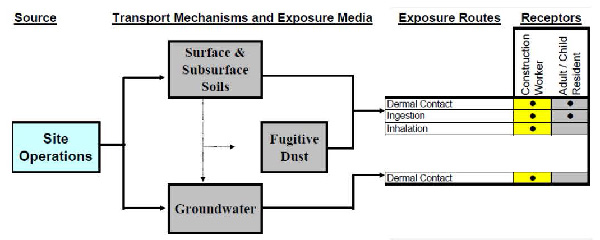Q&A: Risk Assessment
What are the different types of risk assessment and when are they appropriate?
Several human health risk assessment approaches can be completed to set remediation endpoints, determine whether a proposed remedy is adequately protective, or support a “no action” alternative. The risk assessment approach will depend primarily on the laws and regulations governing the project.
Risk assessments fall into two categories: “forward” and “backward.” The “forward” assessments use chemical data to estimate potential health effects and include screening level, site-specific, and baseline types.
Site-specific and baseline “backward” assessments develop health-protective, numeric remediation goals for chemicals when there are no published screening levels or the screening levels are overly conservative.
The following “forward” types of human health risk assessments are appropriate under different circumstances.
Screening-Level Risk Assessment
A screening-level risk assessment is used to quickly differentiate sites in need of further assessment or remediation from sites with negligible risks. This assessment can be performed by calculating the ratio of the chemical concentration to a published numeric level — such as the example published by the USEPA below — and then converting the result to a risk probability or hazard quotient. Although this is the least complex method of risk assessment, it may over-estimate risk because screening levels are calculated using generic, conservative exposure assumptions that may not be appropriate for every site. The resulting conservatism could result in unnecessary site cleanup.

Site-Specific Risk Assessment
Many state cleanup programs and the RCRA Corrective Action Program allow site-specific risk assessment that estimates the health effects of human exposure to site chemicals under current conditions and anticipated future use. A site-specific risk assessment begins with a conceptual site model that identifies chemical sources, transport mechanisms, exposure media, and human receptors and their potential exposure pathways such as incidental ingestion, dermal contact or inhalation. The site-specific risk assessment can consider existing or proposed use restrictions and engineering controls (like surface caps) that eliminate or reduce exposure. When a site-specific risk assessment is conducted, the state or federal cancer-risk and non-cancer hazard thresholds become the standard of measurement for determining whether remedial action is warranted or the proposed remedy is protective.

Baseline Risk Assessment
A baseline risk assessment evaluates risk in the absence of remediation, engineering controls, or institutional controls (such as deed restrictions or covenants), and is required to support development of Superfund remedial alternatives. USEPA will use the results of a baseline risk assessment to determine whether a site presents an “imminent or substantial” danger and make action or no-action decisions. To provide consistency across sites in the federal Superfund program, for example, undeveloped areas are typically evaluated under the conservative assumption that future land use will be residential, which typically requires the most protective action.
Answer provided by Emily Strake, CEP, Senior Project Chemist/Risk Assessor
Emily has 20 years of experience in analytical chemistry and human health risk assessment. Her experience includes assessing the potential adverse health effects to humans from exposure to contaminants in soil, sediment, groundwater, surface water, ambient and indoor air, and various types of animal, fish, and plants. She has been the primary author of risk assessment reports and screening evaluations for projects governed under USEPA RCRA and CERCLA, and state programs in Pennsylvania, New Jersey, California, Virginia, Delaware, Florida, Ohio, Connecticut, Massachusetts, Oregon, and Maryland.
